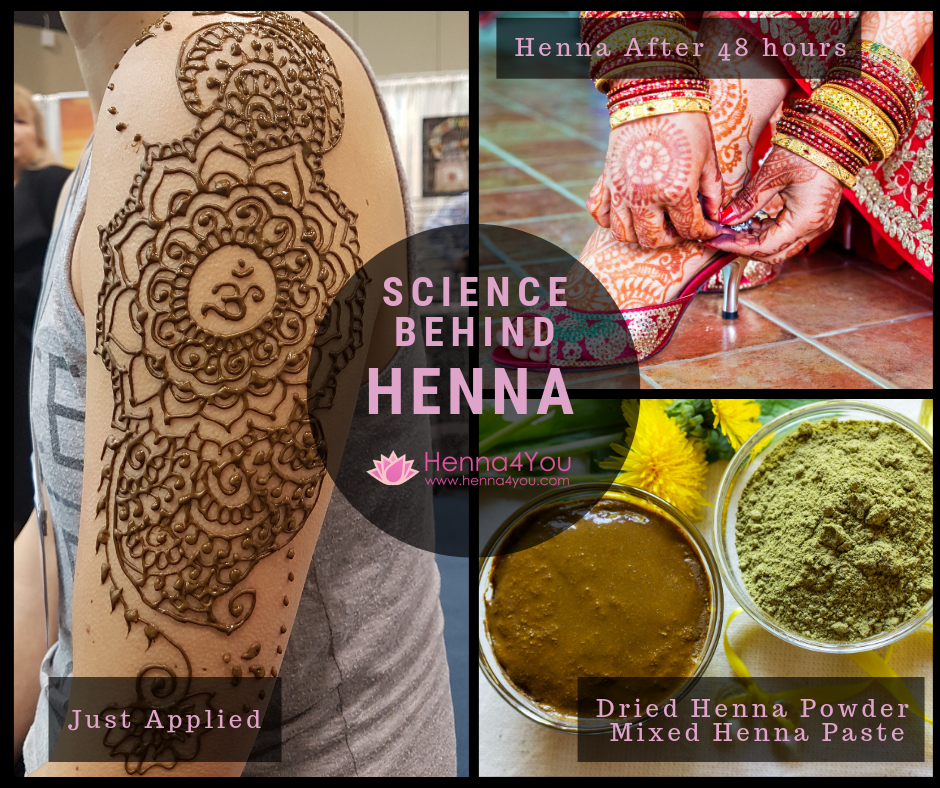The henna plant is a shrub native to Asia, Australia, and northern Africa. It’s very pretty, grows delicate flowers that range in colours from red to white, and so it’s not a surprise to see it in gardens. Historically, cultures found in those regions have harvested the leaves of the henna plant, dried and milled them into a powder for use in henna temporary body art for generations over thousands of years. It’s painless and beautiful, so it’s easy to understand why the practice has persisted and become a fashion statement all over the world.
If you rub henna leaves on your skin you aren’t likely to cause a stain. A chemical in henna leaves, called lawsone, reacts with an acid – in the case of Henna4You’s paste that would be lemon juice – which stains the skin a dark amber colour. This is good because the henna powder alone is green, which we’re sure would still be lovely, but we’re rather attached to the deep red and brown hues we get instead. The lawsone penetrates your skin and its molecules bond with keratin, protein molecules in the outer layer that form a barrier to protect your skin from environmental harm. The longer you leave the henna paste on, the better the molecules bond which will make for a darker and longer-lasting design. If you want your henna to last a few days, leave your henna on until it dries and then gently remove the crust. If you want your henna design to last for weeks, you’ve got to do more work to make those molecules bond, like dabbing at the crust with some sugar water 3 to 4 times. As the outer layer of skin is naturally shed, so, too, will your temporary tattoo.
 Recall that keratin is what the dye bonds with, but keratin is also what protects your skin? This is why it’s critical that you know what’s in the henna paste applied to your skin! Henna4You uses certified organic henna powder, lemon juice, natural sugar, and organic tea tree oil in our paste. All of that is safe for your skin, and your bloodstream. Stay away from henna that is unnaturally coloured, like black or white, or any that is advertised as quick-staining. Those have harmful ingredients that may cause permanent damage to your skin and body.
Recall that keratin is what the dye bonds with, but keratin is also what protects your skin? This is why it’s critical that you know what’s in the henna paste applied to your skin! Henna4You uses certified organic henna powder, lemon juice, natural sugar, and organic tea tree oil in our paste. All of that is safe for your skin, and your bloodstream. Stay away from henna that is unnaturally coloured, like black or white, or any that is advertised as quick-staining. Those have harmful ingredients that may cause permanent damage to your skin and body.
The sugar is added because it’s sticky, and while the henna plant has some sugar in it naturally, it’s not enough to help the paste securely stay the skin long enough for the dye to saturate. Also, as you have noticed, henna designs can be very delicate, so we need the paste to stay precisely where the artist puts it. If you’ve ever iced a cake with runny frosting, you’ll know what we mean! It’s also why there’s sugar in the water you use to dab at the paste throughout the day if your goal is to maintain the stain for a few weeks instead of a few days. Certain essential oils can further help deepen the colour of the henna stain. We use tea tree oil for that, and for its natural ability to kill bacteria.
Still have questions about henna before your application? Call us or send us an email to find out more. Book your next appointment, party, or event by calling 519-741-7007.
